The Google Nexus 9 Review
by Joshua Ho & Ryan Smith on February 4, 2015 8:00 AM EST- Posted in
- Tablets
- HTC
- Project Denver
- Android
- Mobile
- NVIDIA
- Nexus 9
- Lollipop
- Android 5.0
Battery Life
It goes without saying that battery life is one of the most important aspects of a mobile device. After all, a mobile device isn’t really mobile if it can only be used for an hour before running out of battery. In order to test this, we turn to our standard suite of battery life tests, which include our web browser battery life test, along with some compute-bound benchmarks to characterize battery life across various use cases.
However, as the Nexus 9 introduces such a unique CPU architecture, I felt that it was necessary to try and adequately capture the full extent of battery life. To this end, I’ve introduced a new test that is really quite simple but important, as we can start to separate display power from everything else since it can often be the single largest consumer of power in a test. In order to do this, everything that could run during a test is disabled, and the device is placed in airplane mode with the display at 200 nits. A white image is displayed on the screen from a full charge until the device shuts down.
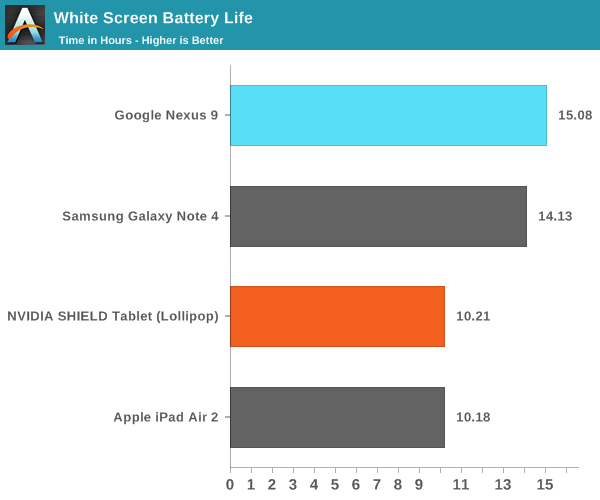
Interestingly enough, the display runtime on the Nexus 9 is about as good as it gets when compared to other devices for which we have data. I suspect we’re looking at the direct result of the large battery combined with an efficient display, as the Nexus 9 can last as long as 15 hours in this test compared to the iPad Air 2’s 10 hours.
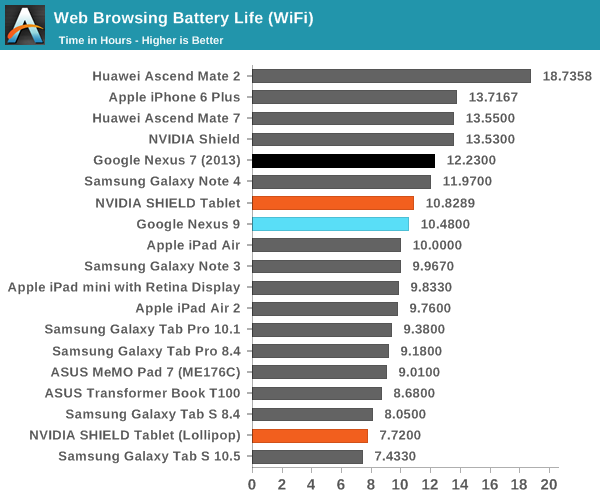
Unfortunately, the massive lead that we saw with the pure display test is significantly eroded in our web browser test. Our web test is primarily focused upon CPU, connectivity, and display efficiency. Seeing as how the Nexus 9’s display is far ahead of the iPad Air 2 and connectivity should be broadly similar in power efficiency, it seems that all of the efficiency gains from the display have gone into powering the Denver CPUs. It’s likely that process has a significant effect on this, so the more valid comparison is between SHIELD Tablet and the Nexus 9. At any rate, the Nexus 9 does manage to deliver solid battery life performance in this test which is definitely a good thing.
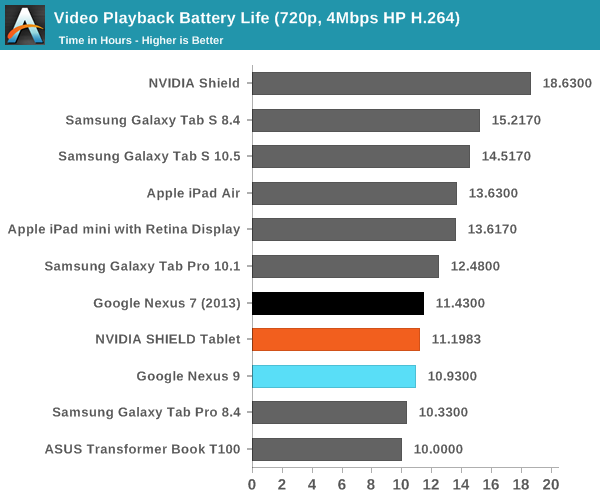
When we move to our pure video test, the Nexus 9 does have a minor regression when compared to the Nexus 7 (2013) and SHIELD Tablet. In this case, the AMOLED displays on the Galaxy Tab S line make for an easy victory due to the relatively high amount of black displayed in the content. The gap is closed between the two devices though, due to a reduced focus on SoC power.
While our web browsing test can give some idea of efficiency, there are often cases where more compute is directly used to support a better experience. To try and test for these compute-bound cases, we use Basemark OS II’s CPU battery life test and GFXBench’s T-Rex rundown for a GPU battery life test. As with the web browsing tests, these are run at 200 nits to keep things relatively equal.


In Basemark OS II, the Nexus 9 does a surprisingly good job as the CPU manages to keep incredibly high sustained performance. The large battery and efficient display seem to help to a significant extent.
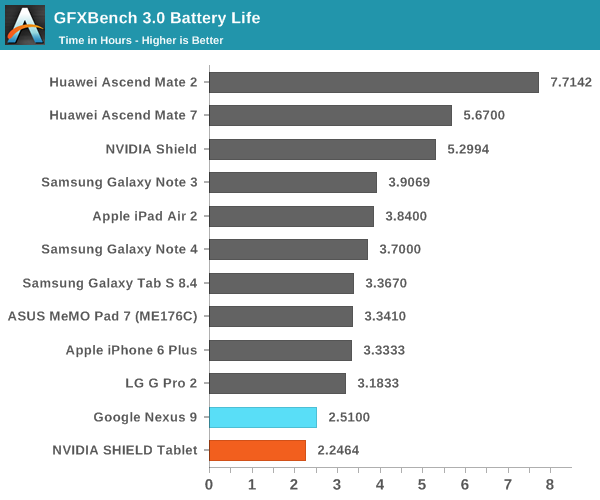
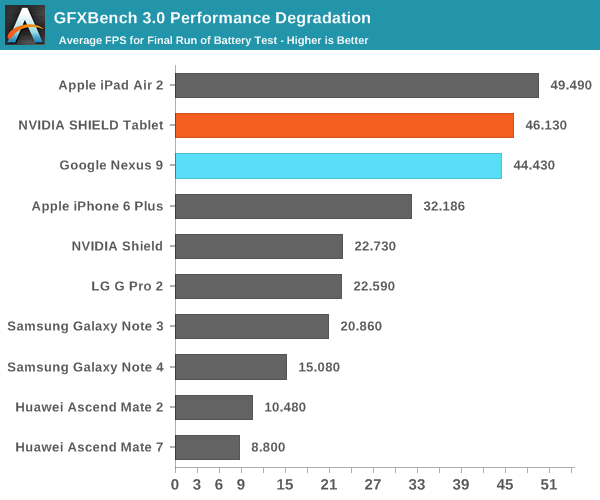
In GFXBench, it seems that not much changes overall. The GPU is definitely more power hungry than the PowerVR Series 6XT line-up and sustained performance is noticeably worse, but it’s in line with the SHIELD Tablet. End of run performance ends up a bit lower, but higher than one might expect. This is likely due to differing ambient temperatures. In practice, skin temperatures are about 45C in this test and localized to the top half of the device, and it’s likely that internal temperatures are around 80C as well. Seeing as how Tegra K1 can theoretically draw 33W in platforms such as the Jetson TK1 dev board with active cooling, it's incredibly impressive to see NVIDIA effectively keep such a powerful SoC within the constraints of a passively-cooled tablet.
Charge Time
While battery life is one part of the equation, charge time is an equally important aspect of overall battery life. To measure this, we measure the time from when charging begins to when the device reaches 100% charge. This is confirmed by taking measurements at the power outlet to make sure that power draw is below a certain level.
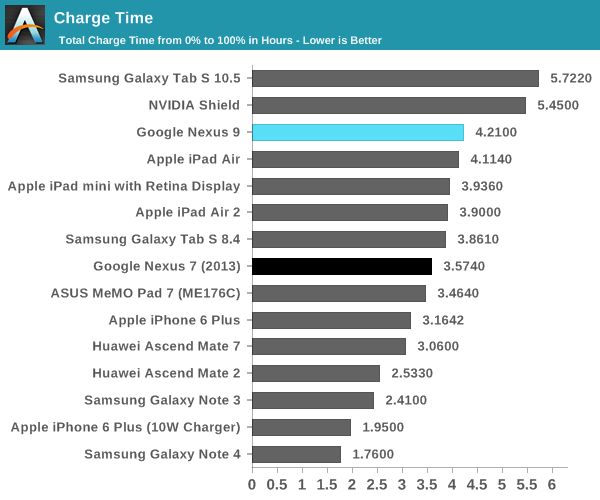
In this regard, the Nexus 9 is merely average for a tablet, although it does fall behind the competition as it uses a 5V, 1.5A charger for 7.5W instead of the 12-15W chargers that we’ve seen recently. It shouldn’t be a big issue, but in general this does mean that devices like the Galaxy Note 4 are actually better at battery life overall when compared to most tablets.










169 Comments
View All Comments
coburn_c - Wednesday, February 4, 2015 - link
High end my rear end. HTC has made high end tablets, HTC makes high end devices, Google makes high end companies make garbage. Seriously. Google devices are done.rpmrush - Wednesday, February 4, 2015 - link
On the cover page it has a tag in the top right saying, "HTX Nexus #2". Should be HTC?cknobman - Wednesday, February 4, 2015 - link
So regardless of how nice the hardware it Android (and more importantly most of its apps) still have major issues when it comes to tablets.Why waste time buying this stuff when you can get a Windows 8 tablet?
I get the best of both tablet and PC worlds in one device without being held hostage by lord overseer Apple dictating my every move or Androids crappy support and busted app ecosystem.
milkod2001 - Wednesday, February 4, 2015 - link
@cknobmanthere's no Windows 8 tablet out there for the same price,with same quality screen and snappiness as this one or Apple tablets. The closest would be Surface3 but it's much more expensive.
If you happen to know about any please post some links please.
rkhighlight - Wednesday, February 4, 2015 - link
Because a Windows 8 tablet is worse than a tablet when it comes to tablet user experience and worse than a notebook when it comes to notebook experience. Most people like to have two separate devices rather than owning a product that tries to combine everything. For some people this works but the majority prefers two product.milkod2001 - Wednesday, February 4, 2015 - link
not necessarily if done right. Lenovo Yoga comes probably the closest with its hybrid(tablet +notebook). It need to be much cheaper if it wants to be acquired by majority though.melgross - Wednesday, February 4, 2015 - link
The Yoga got terrible reviews everywhere. It's hardly recommended.Midwayman - Wednesday, February 4, 2015 - link
I don't think that's true at all. Most people would probably prefer to only pay for one device. The issue is one more of execution than concept. If the surface pro 3 were as light, thin, and as good on battery as high end tablets I certainly would have bought one. At a premium even.Impulses - Wednesday, February 4, 2015 - link
It that were true MS wouldn't be able to keep Surface on the shelves and the market for x86 Atom hybrids at <$500 would be comprised of more than a handful of OEM & models...I think for a certain class of individuals it makes all the sense in the world; students, business travelers, etc. For most people however it's just a compromise on both form factors and not really much of a money saver (specially when you factor the upgrade cycle into the equation).
steven75 - Thursday, February 5, 2015 - link
I have a Windows 8.1 tablet (not RT). It's the worst tablet interface I've used yet. A total bomb. And the touch apps and selection are universally awful.If it didn't have "classic" Windows desktop, I'd have sent it back to the store.